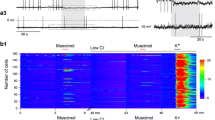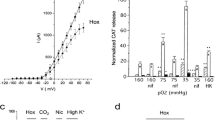Abstract
In the central and peripheral noradrenergic neurons, the balance between noradrenaline release and reuptake determines the level of noradrenaline at the synaptic cleft or the nerve ending. In the present study, we examined the effects of propofol, an intravenous general anaesthetic, on catecholamine secretion and noradrenaline uptake in cultured bovine adrenal medullary cells and on the serum noradrenaline and blood pressure in rats. In cultured adrenal medullary cells, propofol (10–50 μmol/l) concentration-dependently inhibited catecholamine secretion stimulated by carbachol. Propofol suppressed carbachol-evoked 22Na+ influx as well as 45Ca2+ influx at concentrations similar to those which suppressed the catecholamine secretion. Propofol (10–50 μmol/l) also inhibited veratridine-evoked 22Na+ influx, 45Ca2+ influx and catecholamine secretion, whereas it had little effect on the 45Ca2+ influx and catecholamine secretion induced by 56 mmol/l K+. Cultured adrenal medullary cells show [3H] noradrenaline uptake which is sensitive to imipramine. Propofol (10–50 μmol/l) significantly inhibited the imipramine-sensitive uptake of [3H] noradrenaline. In rats, intravenous administration of propofol (2.5 mg/kg) lowered serum noradrenaline and arterial blood pressure. From these findings, in spite of inhibiting noradrenaline uptake, propofol at anaesthetic concentrations (10–30 μmol/l) seems to reduce catecholamine secretion by interfering with Na+ influx through voltage-dependent Na+ channels as well as nicotinic acetylcholine receptor-associated ion channels in the adrenal medulla and, probably, in the sympathetic nervous system. This may explain the propofol-induced hypotension during anaesthesia.
Similar content being viewed by others
References
Amy C, Kirshner N (1982) 22Na+ uptake and catecholamine secretion by primary cultures of adrenal medullary cells. J Neurochem 39:132–142
Barann M, Göthert M, Fink K, Bönisch H (1993) Inhibition by anaesthetics of 14C-guanidinium flux through the voltage-gated sodium channel and the cation channel of the 5-HT3 receptor of NIE-115 neuroblastoma cells. Naunyn-Schmiedeberg's Arch Pharmacol 347:125–132
Catterall WA (1988) Structure and function of voltage-sensitive ion channels. Science 242:51–61
Cena V, Garcia AG, Montiel C, Sanchez-Garcia P (1984) Uptake of [3H]-nicotine and [3H]-noradrenaline by cultured chromaffin cells. Br J Pharmacol 81:119–123
Charlesworth P, Pocock G, Richards CD (1992) The action of anesthetics on stimulus-secretion coupling and synaptic activity. Gen Pharmac 23:977–984
Deegan R, He HB, Wood AJJ, Wood M (1991) Effects of anesthesia on norepinephrine kinetics, comparison of propofol and halothane anesthesia in dogs. Anesthesiology 75:481–488
Doze VA, Westphal LM, White PF (1986) Comparison of propofol with methohexital for outpatient anethesia. Anesth Analg 65:1189–1195
Ebert TJ, Muzi M, Berens R, Goff D, Kampine JP (1992) Sympathetic responses to induction of anesthesia in humans with propofol or etomidate. Anesthesiology 76:725–733
Franks NP, Lieb WR (1994) Molecular and cellular mechanisms of general anesthesia. Nature 367:607–614
Frenkel C, Urban BW (1991) Human brain sodium channels as one of the molecular target sites for the new intravenous anaesthetic propofol (2,6-diisopropylphenol). Eur J Pharmacol 208:75–79
Göthert M, Wendt J (1977) Inhibition of adrenal medullary catecholamine secretion by enflurane:II. Investigations in isolated bovine adrenals-site and mechanism of action. Anesthesiology 46:404–410
Göthert M, Dorn W, Loewenstein I (1976) Inhibition of catecholamine release from the adrenal medulla by halothane; site and mechanism of action. Naunyn-schmiedeberg's Arch Pharmacol 294:239–249
Hartshorne RP, Catterall WA (1984) The sodium channel from rat brain. Purification and subunit composition. J Biol Chem 259:1667–1675
Hasegawa T, Yokotani K, Okuma Y, Manabe M, Hirakawa M, Osumi Y (1993) Microinjection of α-calcitonin gene-related peptide into the hypothalamus activates sympathetic outflow in rats. Jpn J Pharmacol 61:325–332
James R, Glen JB (1980) Synthesis, biological evaluation, and preliminary structure-activity considerations of a series of alkylphenols as intravenous anaesthetic agents. J Med Chem 23:1350–1357
Kawabata K, Sumikawa K, Kamibayashi T, Fukumitsu K, Hayashi Y, Takada K, Yoshiya I (1993) Effect of local anaesthetics on the stimulus-secretion coupling in bovine adrenal chromaffin cells. J Pharm Pharmacol 45:632–635
Kenigsberg RL, Trifaró JM (1980) Presence of a high affinity uptake system for catecholamines in cultured bovine adrenal chromaffin cells. Neuroscience 5:1547–1556
Kilpatrick DL, Spepetis RJ, Corcoran JJ, Kirshner N (1982) Calcium uptake and catecholamine secretion by cultured bovine adrenal medulla cells. J Neurochem 38:427–435
Kirkpatrick T, Cockshott ID, Douglas EJ, Nimmo WS (1988) Pharmacokinetics of propofol (diprivan) in elderly patients. Br J Anaesth 60:146–150
Lingen B, Brüss M, Bönisch H (1994) Cloning and expression of the bovine sodium- and chloride-dependent noradrenaline transporter. FEBS Lett 342:235–238
Lowry OH, Rosebrough NJ, Farr AL, Randoll RJ (1951) Protein measurement with the Folin phenol reagent. J Biol Chem 193:265–275
Meyer DI, Burger M (1979) Isolation of a protein from the plasma membrane of adrenal medulla which binds to secretory vesicles. J Biol Chem 254:9854–9859
Michael-Hepp J, Blum B, Bönisch H (1992) Characterization of the [3H]-desipramine binding site of the bovine adrenomedullary plasma membrane. Naunyn-Schmiedeberg's Arch Pharmacol 346:203–207
Minami K, Yanagihara N, Toyohira Y, Tsutsui M, Shigematsu A, Wada A, Izumi F (1994) Isoflurane inhibits nicotinic acetylcholine receptor-mediated 22Na+ influx and muscarine-evoked cyclic GMP production in cultured bovine adrenal medullary cells. Naunyn-Schmiedeberg's Arch Pharmacol 349:223–229
Pocock G, Richards CD (1988) The action of volatile anaesthetics on stimulus-secretion coupling in bovine adrenal chromaffin cells. Br J Pharmacol 95:209–217
Pocock G, Richards CD (1991) Cellular mechanisms in general anaesthesia. Br J Anaesth 66:116–128
Richards CD (1973) On the mechanism of halothane anaesthesia. J Physiol (Lond) 233:439–456
Richards CD, White AE (1975) The actions of volatile anaesthetics on synaptic transmission in the dentate gyrus. J Physiol (Lond) 252:241–257
Richards CD, Russell WJ, Smaje JC (1975) The action of ether and methoxyflurane on synaptic transmission in isolated preparations of mammalian cortex. J Physiol (Lond) 248:121–142
Sashihara S, Yanagihara N, Kobayashi H, Izumi F, Tsuji S, Murai Y, Mita T (1992) Overproduction of voltage-dependent Na+ channels in the developing brain of genetically seizure-susceptible El mice. Neuroscience 48:285–291
Sebel PS, Lowdon JD (1989) Propofol: a new intravenous anesthetic Anesthesiology 71:260–277
Shafer A, Doze VA, Shafer SL, White PF (1988) Pharmacokinetics and pharmacodynamics of propofol infusions during general anesthesia. Anesthesiology 69:348–356
Skues MA, Prys-Roberts C (1989) The pharmacology of propofol. J Clin Anesth 1:387–400
Smith I, White PF, Nathanson M, Gouldson R (1994) Propofol. An update on its clinical use. Anesthesiology 81:1005–1043
Sumikawa K, Amakata Y, Kashimoto T, Izumi F (1980) Effects of cyclopropane on catecholamine release from adrenal medulla. Anesthesiology 53:49–52
Sumikawa K, Matsumoto T, Ishizaka N, Nagai H, Amenomori Y, Amakata Y (1982) Mechanism of the differential effects of halothane on nicotinic- and muscarinic-receptor-mediated responses of the dog adrenal medulla. Anesthesiology 57:444–450
Sumikawa K, Hirano H, Amakata Y, Kashimoto T, Wada A, Izumi F (1985) Mechanism of the effect of droperidol to induce catecholamine efflux from the adrenal medulla. Anesthesiology 62:17–22
Tachikawa E, Takahashi S, Mizuma K, Kondo Y, Kashimoto T, Takahashi E (1994) Effects of SK&F 96365, an inhibitor of receptor-mediated Ca2+ entry, on Ca2+ influx and catecholamine secretion in bovine adrenal chromaffin cells. Neuroscience Lett 177:155–158
Takara H, Wada A, Arita M, Sumikawa K, Izumi F (1986) Ketamine inhibits 45Ca influx and catecholamine secretion by inhibiting 22Na influx in cultured bovine adrenal medullary cells. Eur J Pharmacol 125:217–224
Thiemermann C, Al-Damluji S, Hecker M, Vane JR (1991) FMRF-amide and l-Arg-l-Phe increase blood pressure and heart rate in the anaesthetised rat by central stimulation of the sympathetic nervous system. Biochem Biophys Res Commun 175:318–324
Vernino S, Amador M, Leutje CW, Patrick J, Darn JA (1992) Calcium modulation and high calcium permeability of neuronal nicotinic acetylcholine receptors. Neuron 8:127–134
Wada A, Takara H, Izumi F, Kobayashi H, Yanagihara N (1985) Influx of 22Na through acetylcholine receptor-associated Na channels: Relationship between 22Na influx, 45Ca influx and secretion of catecholamines in cultured adrenal medulla cells. Neuroscience 15:283–292
Well-Malherbe H, Bone AD (1952) The chemical estimation of adrenaline-like substances in blood. Biochem J 51:311–318
Yanagihara Y, Isosaki M, Ohuchi T, Oka M (1979) Muscarinic receptor-mediated increase in cyclic GMP level in isolated bovine adrenal medullary cells. FEBS Lett 105:296–298
Yanagihara N, Yokota K, Wada A, Izurni F (1987) Intracellular pH and catecholamine synthesis in cultured bovine adrenal medullary cells: effect of extracellular Na+ removal. J Neurochem, 49:1740–1746
Yanagihara N, Minami K, Shirakawa F, Uezono Y, Kobayashi H, Eto S, Izumi F (1994) Stimulatory effects of IL-1β on catecholamine secretion from cultured bovine adrenal medullary cells. Biochem Biophys Res Commun 198:81–87
Yashima N, Wada A, Izumi F (1986) Halothane inhibits the cholinergic-receptor-mediated influx of calcium in primary culture of adrenal medulla cells. Anesthesiology 64:466–472
Author information
Authors and Affiliations
Rights and permissions
About this article
Cite this article
Minami, K., Yanagihara, N., Segawa, K. et al. Inhibitory effects of propofol on catecholamine secretion and uptake in cultured bovine adrenal medullary cells. Naunyn-Schmiedeberg's Arch Pharmacol 353, 572–578 (1996). https://doi.org/10.1007/BF00169178
Received:
Accepted:
Issue Date:
DOI: https://doi.org/10.1007/BF00169178




